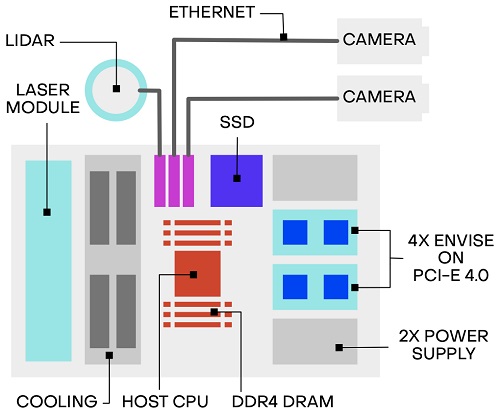
Electrophotonics Bridges Sensor Logjam for Autonomous Vehicles
Photonic computing company Lightmatter, with Boston University College of Engineering and the Harvard John A. Paulson School of Engineering and Applied Sciences, is leading a multimillion-dollar initiative to develop a solution for autonomous vehicles (AVs) that enables the vehicles to deliver high-performance, low-latency computing power that is also energy efficient. The project’s charter calls for the collaborators to develop an electro-photonic computing (EPiC) solution.
Intelligence Advanced Research Projects Activity (IARPA) is funding the $4.8 million project.
To operate safely, AVs use a network of sensors, which consists of multiple sensor types, such as lidar, radar, cameras, and other devices. The data-generating sensors each require trillions of calculations per second. Low-power consumption is a crucial challenge that the AV market faces to deliver competitive vehicle range and performance.
Increasing the number — or the resolution — of sensors is needed to deliver Level 4 and higher autonomous capability, LightMatter says, although deploying more sensor units in AVs is not an option, as it would increase power usage of current transistor-based computers. These computers already consume a significant fraction of the power available to the vehicle.
In the proposed EPiC system, photonics is used to perform large matrix computations, while electronics is used for performing nonlinear operations and storage, the company says. In AVs, the EPiC system is fully integrated with the sensors, and together perform perception, mapping, and planning while overcoming the power and performance limitations of electronics-only computers.
In the past, computer performance improvements that were guaranteed by technology scaling enabled incremental improvements of the computational capacity of transistor-based computers. However, a slowing of the rate of improvement based on technology scaling is creating a widening gap between compute performance and system need. Deploying advanced algorithms, such as deep learning in AVs, requires a new paradigm in computer design that exploits innovative architectures and physics.

The electro-photonic computing (EPiC) system with autonomous vehicle sensors. An industry/academia collaboration is using the system to overcome a common bottleneck affecting autonomous vehicle performance and functionality: delivering optimal computing power without compromising energy efficiency. Courtesy of Business Wire.
The development of photonic chips that compute using photons, not electrons, is spurring the hybrid electro-photonic approach. The photonic chips compute at speeds on the order of tera operations per second, while consuming much less energy. Additionally, the team’s approach relies on the ability to fabricate photonic chip-based computer systems using standard semiconductor fabrication and outsource semiconductor assembly and test processes within existing manufacturing facilities.
The project is funded by IARPA under the Microelectronics in Support of Artificial Intelligence (MicroE4AI) program. The Lightmatter team is led by Darius Bunandar, the Boston University team is led by Ajay Joshi, and the Harvard SEAS team is led by Vijay Janapa Reddi.
/Buyers_Guide/Lightmatter/c32540